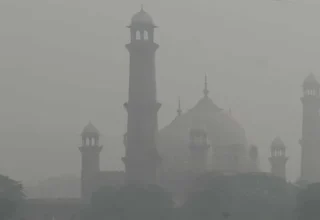
Lahore has once again ranked among the world’s most polluted cities, standing second only to New Delhi, as air quality in the city deteriorated sharply over the weekend.
According to the global air monitoring agency IQAir, Lahore recorded an Air Quality Index (AQI) of 209 on Sunday, a level considered “very unhealthy” while India’s capital New Delhi topped the list with an AQI of 218.
The Punjab Environmental Protection Department (EPD) reported that easterly winds are contributing to the rising pollution levels in Lahore. The department warned that the city’s average AQI is expected to remain between 195 and 210, posing severe health risks to residents.
Experts have cautioned that the situation may worsen in the coming days due to Diwali fireworks in neighboring India, which are likely to increase cross-border pollution. Health specialists have advised citizens, especially children, the elderly, and those with respiratory illnesses, to stay indoors as much as possible.
The Pakistan Meteorological Department stated that wind speeds will remain between 1 and 9 km/h, with a brief period of mild wind during midday expected to bring temporary improvement in air quality. Between 12 p.m. and 5 p.m., the AQI could drop to 150, but it may rise again to 165–200 in the evening hours.
In response to the worsening smog, the Punjab government has intensified its anti-smog operations across Lahore. Under the directions of Chief Minister Maryam Nawaz Sharif, teams from the Environment Protection Force, Police, WASA, and district administration are jointly cracking down on smoke-emitting vehicles, overloaded trucks, and uncovered construction material transporters entering the city.
Authorities have also begun nighttime water-sprinkling operations at construction sites to reduce dust emissions. The Chief Minister has instructed all departments to submit daily progress reports and to enhance public awareness campaigns about the dangers of smog.
Meanwhile, a province-wide campaign against crop residue burning is underway. The EPD reported that 91 balers and 814 Kubota machines are being used to collect leftover straw from millions of acres, turning it into animal fodder instead of burning it.
Environmental experts have termed these steps as positive measures that could help curb smog formation and gradually improve the region’s air quality.































